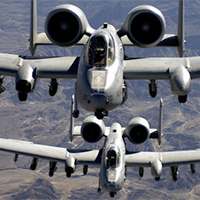Air Force, lawmakers clash over future of A-10

The fate of the A-10 close-air support platform has been the most contentious issue between the Air Force and Congress over the last six months. If comments made Tuesday are any indication, it’s a fight that isn’t going away.
At a hearing called to discuss the future force mixture among active, Guard and Reserve components, Secretary Deborah Lee James and Chief of Staff Gen. Mark Welsh ran into an A-10 themed assault in the form of Arizona Republican Sen. John McCain.
It was clear from his opening statement that McCain planned to put the service leaders back on their heels. His first question was about how the service planned to fill the CAS role.
James began her response by mentioning the F-15E, F-16 and B-1, all platforms that have filled the CAS role in Afghanistan. But McCain was unimpressed, particularly with the secretary’s statement that the B-1 could fill that mission.
“That’s a remarkable statement,” McCain said. “That doesn’t comport with any experience I’ve ever had, or anyone I know has ever had.” And he was just getting started.
“See, this is an example,” continued the senior senator from Arizona. “You’re throwing in the B-1 bomber as a close-air support weapon to replace the A-10. This is the reason why there is such incredible skepticism here in the Congress, and believe me, under the present environment — I can’t speak for the committee, I can only speak for myself and several others — you will not pursue the elimination of the finest close-air support system in the world with answers like that.
“So I hope you will come up with something that is credible for those of us who have been engaged in this business for a long time.”
For the record, the Air Force has flown CAS missions with the B-1 in Afghanistan for several years, and increasing the use of platforms like the B-1 has been a key component of the service’s plan to fill any mission gap caused by the A-10 divestiture since it was announced.
Air Force figures show that the A-10 has performed 19 percent of CAS operations in Iraq and Afghanistan from the start of 2006 to October of 2013. In contrast, the B-1B has performed 8 percent, the F-15E 12 percent and the F-16 33 percent. The remaining 28 percent has been performed by “other US fixed wing” platforms.
Welsh cited service figures that the F-16 has flown 40,000 CAS hours in Afghanistan since 2006. But his tone also turned combative when bringing up the reason the service says it needs to make these cuts.
“I think the issue here is all of our fleets of aircraft represent an incredible investment of resources over time by the Congress, but the nation and the laws that govern us have decided to spend less on DoD funding,” Welsh said. “We are cutting capability and capacity in every single mission area of the United States Air Force for [the fiscal 2015] budget. We will not be able to fully replace that mission capacity in any mission area and we will not be able to save all the people in those mission areas and still meet the budget.”
McCain, whose home state stands to have an A-10 reserve unit replaced with F-16s, remained unimpressed.
“I’ve yet to meet, general, an Army commander whose responsibility is with the troops on the ground, that believes a B-1 or an F-16 replaces the capability of the A-10,” McCain said. “If you know of someone I’d be glad to meet and talk to them. Those are the ones whose judgment I rely on because they’re the ones whose people are in harm’s way.”
Interestingly, Sen. Kelly Ayotte, the New Hampshire Republican who has led the defense of the A-10, was all smiles for the Air Force leadership. Ayotte didn’t mention the A-10 cuts, instead staying on topic at the hearing and concluding that the work between the Air Force and the commission “was very well done.”
Reading into one hearing can be dangerous, but the change in attitude between Ayotte’s comments today and in previous hearings was notable. Whether that relationship thaws or not will go a long way in determining the fate of the Warthog.
Meanwhile, McCain seems to have another fight lined up with the Air Force, this time on the protest filed last week by SpaceX against the service over its decision to award the United Launch Alliance a sole-source contract for rocket launches.
“I’ve asked for an inspector general investigation into this whole process,” McCain said, addressing James. “We need competition and I won’t give into all the responses you gave me before. Your responses don’t hold water.”
James, for her part, said she welcomed an investigation by the IG’s office “because getting a new set of eyes and ears on this competition question will be of help to me.”
One of the core issues seized by McCain is the continued use of the Russian-made RD-180 in the United Launch Alliance’s Atlas V rocket.
“As far as the RD-180, that is of course worrying, that is under review, and we expect to have more to say from that review on the way ahead in the next month,” James said.
A larger review of the RD-180 has been completed and is working its way through the Pentagon, according to Rear Adm. John Kirby, Pentagon press secretary.